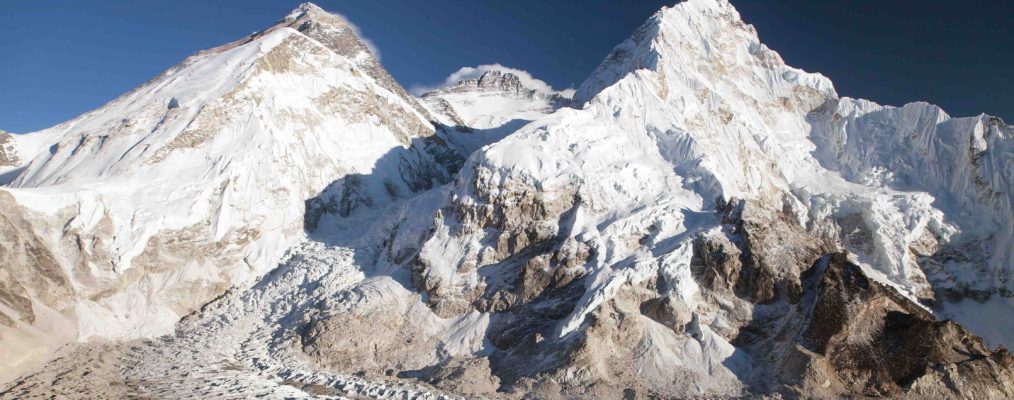Also known as Sargamatha, Chomolungma, or just 'the world's highest peak'
Mount Everest needs little introduction. The highest mountain in the world, it stands proud as a hulking mass of a mountain, rearing up between Tibet to the north and Nepal to the south. It attracts hundreds of mountaineers each year, who with the support of an army of local Sherpas attempt to reach the top of the world. There is a long British association with the mountain, with early expeditions to the peak led by Brits, including the ill-fated attempt by George Mallory and Andrew Irvine to reach the summit in 1924. When the mountain was finally climbed in 1953 by Nepalese Sherpa Tenzing Norgay and Kiwi climber Edmund Hillary it was as members of a huge British team led by the army Colonel John Hunt, and was celebrated as a national victory.
South-East Ridge
The original route on the mountain, and the most climbed today, the South-East Ridge or South Col route starts at an often trekked to basecamp located at the head of the beautiful Khumbu Valley. From there the Western Cwm, the glacial valley leading up to the South Col, is reached by passing through the Khumbu Icefall, a notoriously tricky area of deep crevasses and towering seracs. Passage through this obstacle is made possible by the addition of fixed ropes and long ladders, but with sections of ice cliffs regularly collapsing this section poses a serious danger to climbers. From a high camp at the South Col the route then follows the South-East ridge proper to the summit, passing the famous Hillary Step, which partially collapsed following the huge Earthquake in 2016.
North-East Ridge
The normal route from Tibet, the North-East Ridge Standard, or North Col route as it is sometimes known, ascends from a rocky basecamp at 5000m on the barren Tibetan plateau. Climbing from the North avoids the dangers presented by the Khumbu Icefall, but this is swapped for longer times spent above 8000m and harsher conditions, with stronger winds and colder conditions to contend with. Like on the South Col route, fixed ropes are put in place by a large team of Sherpas, used to safeguard the passage of their clients to the summit.
South West Face
The first ascent of the South West face marked the end of an era, being the last of the huge siege-like expeditions conducted by a British team in the Himalaya. Led by Chris Bonington, over several expeditions the defences of the huge face were probed, until Doug Scott and Dougal Haston, reached the summit in September 1975. From this point onwards cutting-edge expeditions to Everest tended to adopt more alpine-like tactics, with smaller teams climbing in a lighter style, including lightning fast oxygen-free ascents from renowned Alpinists such as Reinhold Messner and Erhard Loretan.
‘Chaos at Camp 1’, by Jo Bradshaw (T&M issue 62, Jun 2015)
‘Everest 60: 1953-2013’ (T&M issue 39, May 2013)
‘Trouble at the top’, by Matthew Dieumegard-Thornton (T&M issue 33, Oct 2012)
How to get there:
For routes starting in Nepal, fly into Kathmandu and then take an internal flight to Lukla. From here the famous Everest Basecamp trekking route is followed through stunning mountainous scenery, past beautiful Buddhist monasteries. For those climbing from the North a more austere approach is involved. After flying to the Tibetan capital of Lhasa several days are spent driving up a recently tarmacked road to base camp.
Outfitters:
There are a number of both local and western companies offering services on the mountain, from base camp logistics through to fully guided, Sherpa supported trips to the summit. These all come at a price, with a one-to-one trip with a well-known western guide coming with a six-figure price tag. Recommended companies include www.jagged-globe.co.uk and www.adventureconsultants.com
Permits:
Climbing Everest certainly isn’t cheap, with both the Nepali and Chinese governments charging the hefty sum of $11,000 for the privilege of setting foot on the mountain. Choosing to ignore the requirement of having a permit is out of the question, Everest is a very public place to climb and attempting to dodge the system is not tolerated.






